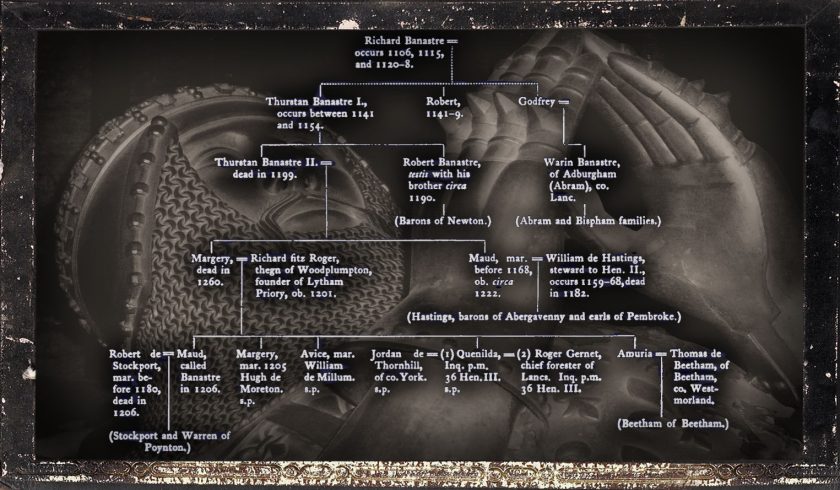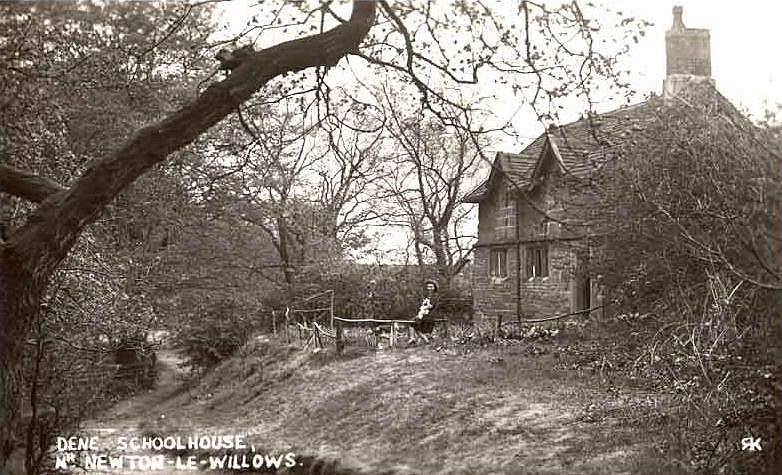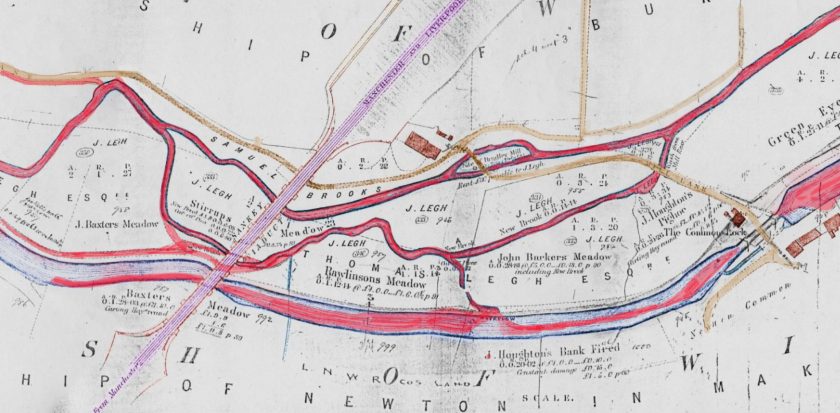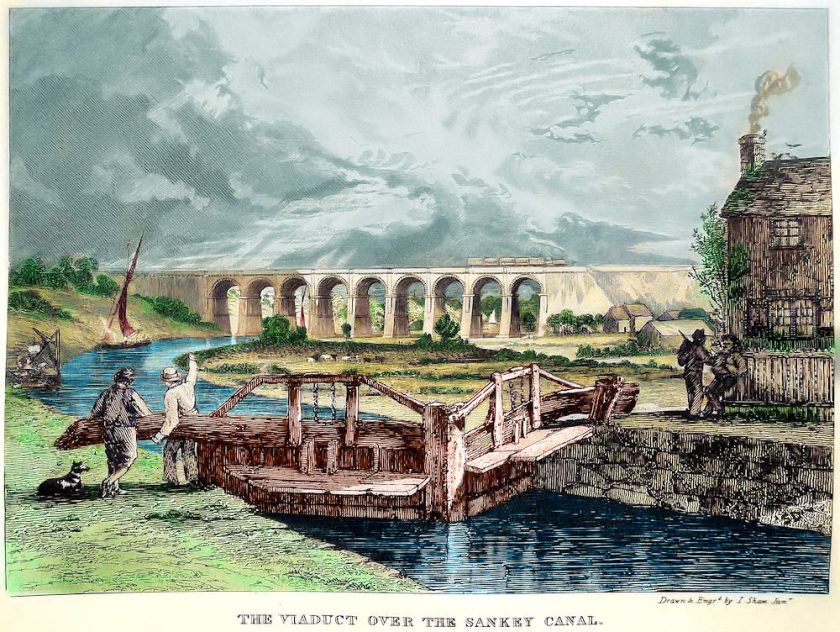Historical Overview
This liberty is almost conterminous with the Domesday hundred of Newton. During the twelfth century, it was included in the ‘corpus comitatus,’ or sheriff’s charge, at the assized rent of £8 16s. 4d., increased to £11 11s. 4d. in the year 1201. When Robert Banastre received it from Henry II, these lands appear to have been subject to the yearly payment of the former sum. When delivered to his son by the crown in 1204, the tenure was partly by knight’s service and partly in socage.
The Banastre Family
The name of Banastre appears to be a corrupted form of the Italian ‘balastro’ (Lat. Balistarius), one who manipulates the ‘balestra,’ or machine for hurling stones against a fortification. From Balestro, the name became changed to Banastre by the same process by which baluster (the handrail of a staircase) has taken the now accepted form of banister. In the court of the earls of Chester, the Balestro, or Banastre, appears to have been an official of great importance. The late Mr. Langton deduced the name from old French, ‘Banaste’ (Lat. Banasta), a basket or creel, such as may be slung in pairs across the back or over a pack-saddle, hence the heraldic emblem known as the water bouget. He further adduces in support of this derivation the appearance of the water bouget in the early arms of the Banastres.
Early History and Genealogy
If we may believe the statement of a notable petition made by one of the subjects of this notice in 1278, the family of Banastre descended from Robert de Roelent (Rhuddlan), who held a large fee, described in Domesday as including half the castle, burgh, and manor of Rhuddlan, and some thirty-three berewicks in Englefeld, now part of co. Flint. If so, the descent was probably through a daughter of Robert de Roelent. Richard Banastre, the first of this family upon record, occurs among the attestants of a charter of Richard, earl of Chester, and the Countess Ermentrude, his mother, confirming to the monks of Abingdon the grant of ‘Wudemundeslai’ made by Drogo de Andely. The first three witnesses of this charter are William fitz Nigel (the constable), Hugh fitz Norman (the steward), and Richard Balasta. The date is stated to be circa May, 1106. In another charter, reciting William Malbanc’s gifts to the abbey of St. Werburgh, of Chester, Banastre’s name appears next after that of the countess in the testing clause. About 1115, he attests an important charter of Richard de Belmeis, bishop of London, then viceroy of Salop, touching the claim of Wenlock Priory to St. Milburg’s land in Shropshire, he being the second lay witness. Between 1120 and 1128, he is a prominent witness to Ranulf Meschin’s charter of confirmation to St. Werburgh. In the history of Shropshire, Mr. Eyton adduces evidence to show that Richard Banastre was probably lord of Munslow and Aston Munslow in that county.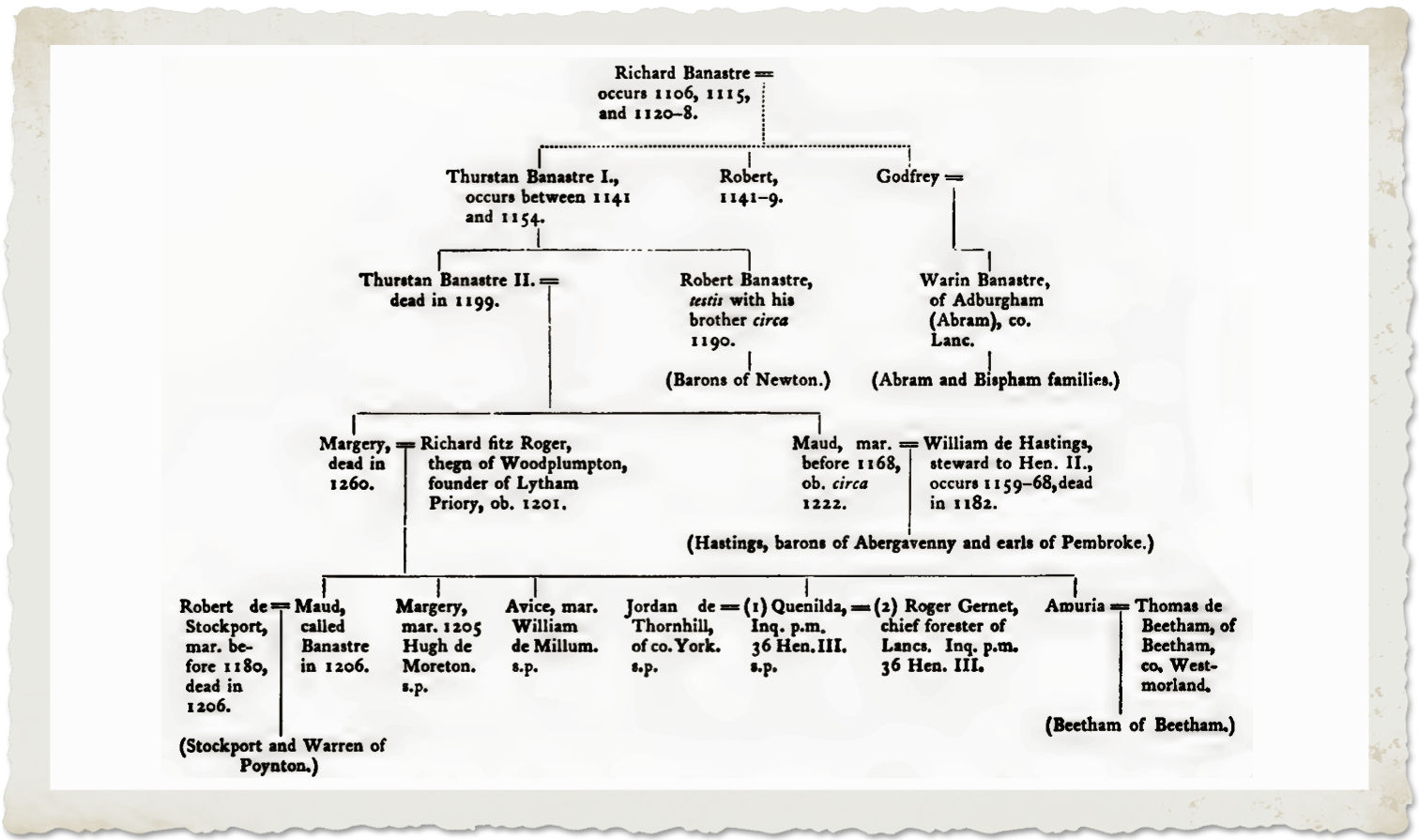
Succession and Estate Division
His successor, both in Cheshire and Shropshire, was Thurstan Banastre, probably his son. In proof of his dignity, as one of the earl’s chief barons, we find his name standing as the third witness, following William, earl of Lincoln, and William de Percy, of the charter by which Ranulf Gernons, fourth earl of Chester of his line, acknowledges and appoints Eustace fitz John to be his hereditary constable. This charter probably passed in the earl’s palatinate court between 1149 and 1154. Of about the same, or perhaps rather earlier, date is the charter of Earl Ranulf releasing to the monks of Shrewsbury his toll in the city and county of Chester. This was given at Shrewsbury and is tested by Ralph, abbot (of Shrewsbury?), Robert, the earl’s steward, and ‘Thurstan Bannestre.’
Evidence is wanting to enable us with absolute certainty to connect other contemporary members of this family with Thurstan Banastre, but Robert Banastre, the first of the Lancashire family of that name, and Alard Banastre, sheriff of Oxfordshire from Easter, 1170, to Michaelmas, 1175, may have been younger sons of this Thurstan. No doubt exists as to the ultimate successors of Thurstan in his Cheshire, Lancashire, and Shropshire estates. These were two sisters, Maud, the younger, wife of Henry II’s steward, William de Hastings (occurs 1159-1168, dead, 1182), whom she married in or before 1168, and Margery or Margaret, the elder, wife of Richard fitz Roger, thegn of Woodplumpton, in this county, and the founder of Lytham Priory, whom she married before 1176. Margery’s husband is mentioned in the Pipe Roll of 1180, as owing a fine of £100 for the recovery of his Lancashire lands, which had been seized by the crown because he had given his eldest daughter and heir in marriage to Robert de Stockport without the king’s licence. He died in 1201, and his wife was deceased in 1206.
Although the sisters Margery and Maud were daughters of Thurstan, it is probable that they were grandchildren of the Thurstan who occurs between 1141 and 1154, and daughters of Thurstan II, seeing that Maud, the younger, was married before 1168 and survived until 1222. In 1219 she was still a widow and had lands in Kirmington, co. Lincoln, worth ten marks per annum. In the division of their father’s estates, which was not effected without recourse to the king’s court, the Shropshire estates of Munslow and Aston fell to the share of Maud, in whose descendants, the barons of Abergavenny and earls of Pembroke, these manors descended. To Margery and her heirs fell the manor of Appleby, in Leicestershire, with the church, the manor of Kirkby in this county, held of the constables of Chester, together with Simonswood appurtenant to it, and the manor of Aughton, of which the family of Waleys, or Walsh (Walensis), were undertenants; but so far as can be ascertained the Cheshire estates descended in the line of Robert, younger brother of Thurstan Banastre II.
Further Petitions and Settlements
We now return to Robert Banastre, the younger brother of Thurstan II. In a petition presented in Parliament in the sixth year of Edward I., 1278, the great-grandson of this Robert declared: “that his ancestor Robert Banastre, came to England with the Conqueror and had the manor of Prestatyn ‘in Englefeld ‘ (co. Flint) and other lands which the petitioner still holds of conquest by the Conqueror (du Cunquestre par le Cunqueror), which the said Robert held for a long time. Who died possessed of that land, leaving his son Robert Banastre, who during the time of King Richard built a tower at Prestatyn which still remains. In whose time Owen Gwynedd, lord of Wales, made war in the land whilst the king was over the sea, and having taken the king’s castle of Rhuddlan, drove all the king’s subjects out of the land. Thus Robert, the son of Robert Banastre, lost his land in Wales and brought all his people from Prestatyn, and from thence into Lancashire, where they are still called Le Westroys. At his death Robert left three sons, Richard, Warin, and Thurstan, and during all his time Llewelyn, the elder, made war. When Thurstan died he left one son named Robert, aged but one year at his father’s death, being twenty years in ward, who when he came of age, lived but three years before he died, leaving one son, Robert, the petitioner, who was in ward nineteen years. He prays the king for an inquest to be held by Englishmen, to declare his right to the manor of Prestatyn, because the king has twice before commanded inquest to be made by Englishmen and Welshmen jointly assembled, but the Welsh refused to attend, declaring it to be contrary to their franchises, unless all the people of the district be at the inquest, whereby Robert suffers delay to his great loss, and prays the king for remedy, if it pleases him.”
By inquest held in accordance with the king’s writ dated 24 October, 1279, it was found that King Richard gave the manor of Prestatyn to Robert Banastre, the petitioner’s grandfather (sic), to hold by his service in fee and inheritance, that Robert thereafter held the manor in peace by the space of 35 years, within which time he built a tower which remained in part to that day, and thereupon Owen Gwynedd, Prince of Wales, drove him out of the manor and threw down his tower there.
Whilst the petition and inquest contain some genealogical and chronological inaccuracies, they no doubt in the main record the true fact that Prestatyn was granted by Henry II. to Robert Banastre, possibly for his good services in the war of
1165, when he, with Randle de Bylines and William de Curcy, was commissioned to munition and defend the castles of Basingwerk, Rhuddlan, and Prestatyn. Between 1154 and 1157, the king confirmed various grants to the abbey of Basingwerk, including land called Kethlenedei given by Robert Banastre. The grantor of these lands was no doubt that Robert who takes an important place in the attestation clause of several of the charters of Ranulf, third earl of Chester of his line, which belong to the period 1141-9, but he belongs rather to the generation of Thurstan I., whilst the grantee of Prestatyn was a younger brother of Thurstan II. About the year 1165, the vill’s of Walton-le-Dale, Mellor, Eccleshill, Little Harwood, Over and Nether Darwen, all within the hundred of Blackburn and honour of Clitheroe, were granted by Henry de Lacy, lord of Pontefract and Clitheroe, to Robert Banastre to hold by the service of one knight’s fee. Soon after Robert’s expulsion from Prestatyn with his Welshmen or Westreys as they were called, and doubtless in compensation for the loss of Prestatyn, he obtained a grant from the crown of lands within the lordship of Makerfield, including the demesne lands of Newton and the rectory manor of Wigan with the advowson of the church. The absence in the Lancashire Pipe Rolls of any reference to this grant before the time of John seems to suggest a doubt whether Robert Banastre’s tenure was more than that of farmer or bailiff.
Settlers and Grants
One of the tenants of this lordship at the date of the great inquest of service taken in 1212 was Robert de Adburgham, who is described as holding 4 oxgangs of land in Adburgham, now Abram, by the gift of King Henry in fee farm by rendering 4s. yearly. Now the original grantee of this land from Henry II. was undoubtedly Warin, son of Godfrey Banastre, father of Richard de Adburgham and of Henry de Bispham, and donor of one oxgang of his demesne land in Abram to the canons of Cockersand. By his charter, to which Thurstan Banastre and Robert, brother of Thurstan—and note the relationship—and Richard, the grantor’s son, are attestants, he confirmed the grant of land in Abram, called Ockelshaw, made by his nephew William de Ockelshaw to the same canons for the health of the soul of King Henry, and of the soul of Warin Banastre. These grants were made about 1190, and supply the only contemporary evidence that we have found of the settlement of the Banastres in Makerfield before the end of the twelfth century and of the probable nature of their tenure.
To the circumstances related above is to be traced the settlement in the county of numerous families of Welshmen, who soon exchanged their native patronymics for territorial names. Certain letters close of Henry III., directed to the sheriff in the year 1229, afford evidence of the very considerable numbers of these settlers, then and long after known as ‘Banastre’s Welshmen.’ In accordance with a precept to tallage the demesne manors, and manors formerly in the demesne of the county, the sheriff had assessed these men to a tallage of 20 marks, against which they had protested, as being entirely contrary to the custom under which they and their predecessors had enjoyed immunity from tallage. The demand was put in respite, and nothing more heard of it.
Banastre Heirs and Estates
Robert Banastre probably died during Richard’s reign, leaving three sons, Richard, Warin, and Thurstan, all probably under age. Richard, the eldest, died during his minority without issue. In 1201, Adam de Lowton and Thomas de Goldborne answered for the scutage of one knight’s fee, by which service Newton, Lowton, Kenyon, Arbury, and half of Golborne were held. Upon attaining his majority, Warin, the second son, in 1204 proffered 400 marks, payable within four years, to have the land of Makerfield, and was put in seisin shortly before Michaelmas that year. A grant of land in Walton, apparently made by this Warin to one Alvred, has a seal appendant, bearing either two water bags suspended in netting, or a pair of wickerwork panniers. Before 3 April following, Warin was dead, and Sarah his widow had obtained a small annuity for her living from an ungenerous sovereign. A few days later, the king exercised his right of presentation to the church of Wigan, in his gift by reason of Warin’s death. In 1213, Thurstan, the third son, having attained his full age, proffered by the hand of Geoffrey, dean of Whalley, 60 marks for an inquiry touching his right to Makerfield, which by inheritance ought to descend to him from Robert Banastre, his father, and Warin, his brother, and pending a favourable verdict proffered 500 marks for seisin. A month later, he was put in possession. In addition to lands holden of the honour of Clitheroe, he held Standish and Langtree of the honour of Penwortham, as mesne tenant. To Cockersand Abbey, he gave half the vill of Arbury. He died in 1219, leaving a son, Robert, and other children all of tender age. Philip de Orreby, justice of Chester, having given 50 marks for the wardship of the heir with his marriage, had livery of the inheritance. The widow, Cecilia, at the king’s request, married Richard de Monhaut. One of the few recorded acts of Robert was the grant to his brother Thurstan, of lands in Newton in Wirral, by charter sealed with three chevronels. This manor long descended in the family of Venables of Kinderton, who held it of Banastre of Bank, in this county, a younger line of some importance, said to be descended from Thurstan Banastre, the grantee.
Subsequent Generations
Robert Banastre married dementia, whom conjecture assigns as daughter to Philip de Orreby, by reason of the fact that this Robert was the first to use for arms three chevronels, a charge said to have been used by the family of Orreby. She survived her husband, but died before 1258. The petition of 1278 already quoted records the death of this Robert within three years after attaining manhood’s estate, that is to say, in 1241 or 1242. He left issue two sons, John, who died before the end of February, 1242, and Robert, who was a minor at his brother’s death. He possessed in 1242 in demesne half a knight’s fee in Makerfield, held of the earl of Ferrers, and the fourth part of a knight’s fee in Shevington, Charnock Richard, and Welch Whittle, held of the fee of Penwortham, in addition to his fee in Walton-in-le-Dale, held of the honour of Clitheroe, which latter had been granted during his minority to the prior of Penwortham at the rent of £15 12s. 11d. per annum. He was a ward nineteen years, and therefore did not come of age until 1260 at the earliest. He was thus only five years old in 1245 when he manumitted two of his natives of Poulton, near Warrington, a liberty extended to other natives of Ashton and Newton, in Makerfield, in 1256. He obtained on 13 January, 1257, a charter of free warren in his demesne lands of Walton-in-le-Dale, Newton-(in)-Makerfield, and Woolston, near Warrington, and in December of the same year a weekly market on Tuesday, and an annual fair on the eve, the feast, and the morrow of St. German the bishop, at his manor of Newton.
In November, 1268, he was appealing Richard de Holand and eight others in the king’s court for the destruction of his fish pond at Newton, and for carrying away and imprisoning his wife and sons. He was commissioned in 1279 with two others to inquire of those in the county having land to the value of £20 yearly who had not taken up knight’s service. The same year he was commissioned to inquire of trespasses done in the forests of Lancaster. In 1280 he was one of the justices appointed for the gaol delivery at Lancaster. We have dealt at length with the petition which he presented in Parliament in 1278 for the recovery of the manor of Prestatyn, lost by his great-grandfather a hundred years before. He failed to obtain a re-grant of this estate, but there is some evidence that in lieu thereof the king gave him the manor of Little Mollington, co. Chester, afterwards known as Mollington Banastre, to hold by the service of a fourth part of a knight’s fee. In 1284, whilst Richard was prior of St. Oswald’s of Nostell, Robert Banastre obtained licence for a chantry in his manor of Rokeden in Newton, in return for which he endowed the church of Winwick with a yearly rent of 12d. for lights for the altar of St. Mary the Virgin. To Cockersand Abbey, he confirmed all grants of land made by his tenants in Makerfield, but reserved
‘Infangenthef et Utefangenthev’ over the tenants of those lands, as pertaining to him by reason of his barony. To the monks of Stanlaw, he gave ten acres of land adjoining the chapel of the Low in Walton, and estovers in his wood there. He married Alice, daughter and heir of Gilbert Woodcock, who had lands in Cuerden by the feoffment of Roger, son of Henry de Cuerden. She survived her husband, whose death occurred in 1291.
Later Lineage
He had issue one son, James, who predeceased his father, and a daughter Clemence, who had Mollington Banastre in marriage with William de Lea, of Lea, near Preston, whose son Henry de Lea, kt., was beheaded in 1315 for participation in the rising which Adam Banastre, kt., led against Thomas, earl of Lancaster; and a daughter Sibil, married to Richard de Hoghton, of Hoghton, kt. James Banastre married Elena, daughter of William the butler, of Warrington, and had issue an only daughter Alesia, who was contracted in marriage to John, son of John de Byron, kt. John de Byron, the father, was guardian of Alesia and of a portion of her inheritance in 1292, at which time she is described as being under age and the wife of the younger John de Byron, in the record of a plea at Lancaster, in which she and her husband had been summoned to prove their warrant to hold a market and fair in Newton and to have free warren there and in Makerfield, Woolston, and Walton-in-le-Dale.
Before November, 1295, young John Byron was dead without issue, and the earl of Lancaster had granted the marriage of his widow to his friend John de Langton for 250 marks. The grantee was probably John de Langton, Keeper of the Rolls to Edward I., appointed chancellor in 1292, and bishop of Chichester in 1305. If so, he married the heiress to his younger brother, also named John, before the end of 1297, when John de Langton and Alesia his wife were found to hold a knight’s fee in Newton of Edmund, earl of Lancaster. Early in 1301, John de Langton, brother of the chancellor, at the latter’s instance, obtained a grant of a weekly market, two fairs yearly, and free warren in Newton in Makerfield and also in Walton-in-le-Dale. His wife, who was living in 1310, predeceased him. As John de Langton, kt., he had frequent letters of protection from Edward II while in his service. He was living in 1328, but died before July, 1333. In 1325, he was in the retinue of the earl of Warenne in Guyenne, and the year previous was summoned from co. Leicester to attend a great council at Westminster.
His son Robert de Langton, chr., was one of the commissioners of array in this county in 1335 to raise troops in the county and lead them to the marches of Scotland. In 1341, he had a licence to crenellate his mansion of Newton in Makerfield. In 1344, he was one of the commissioners of array for the raising of 500 archers in the county for service in Scotland. Upon the collection of the aid granted in 1346, he was returned as holding of Henry, earl of Lancaster, one knight’s fee in Walton-in-le-Dale, and one knight’s fee in Newton in Makerfield, Lowton, Kenyon, Arbury, and the moiety of Golborne. He died in 1361, his eldest son John having predeceased him, leaving issue Ralph, who was found heir to his grandfather in January, 1362, being then aged twenty-one years and upwards. During his grandfather’s lifetime, the manors of Newton and Walton had been settled upon his father, whilst the third part of the manor of Langton, co. Leicester, the manor of Hindley, and half the manor of Golborne were settled upon Robert, younger brother of John de Langton.
The Langton Legacy
Ralph de Langton, kt., was a witness in the Scrope and Grosvenor case in 1386. In 1391, he settled lands upon his son and heir, Henry, in marriage with Agnes, daughter of John de Davenport, and five years later, in conjunction with his wife Joan, daughter of William de Radcliffe of the Tower, settled lands on his three younger sons, Nicholas, Thomas, and Geoffrey. He died 7 April, 1406, leaving Henry his son aged 40 years. Henry Langton paid £8 for relief of his lands in January, 1407, and died in 1419, Ralph his son and heir being then aged twenty-three years. Ralph Langton, chr., married Alice, whose parentage is unknown, and died in 1431, leaving issue an only son, Henry, then aged twelve years, in ward of Thomas Longley, bishop of Durham, and others, who were returned the same year as holding half the manor of Newton; Alice, relict of Ralph Langton, chr., and Agnes, relict of Henry Langton, each holding a fourth part of the manor in dower. Henry Langton, esq., died in 1471, and two years later his son Richard was found to be of full age. Richard Langton, kt., was made a knight banneret by Lord Stanley at Hutton Field in 1482, on the return of the army from Scotland. He married Isabel, daughter of Thomas Gerard of Bryn, kt., and died in 1500, leaving issue Ralph, aged twenty-six years, who had been married to Joan, daughter of Christopher Southworth of Samlesbury, during his father’s lifetime. Thomas Langton, styled baron of Newton, great-grandson of Ralph, was made a Knight of the Bath at the coronation of James I.
The Langton-Hoghton Conflict
In 1589, he was involved in a fatal affray at Lea Hall, when eighty of his tenants and servants engaged with thirty tenants and servants of the owner of that place, Richard Hoghton of Hoghton Tower, esq., in an attempt to recover cattle seized by Mr. Hoghton, and as a result of other mutual provocations. Mr. Hoghton was unfortunately slain, and although no jury could be empanelled to try the indictment preferred against Sir Thomas and his accomplices for murder, the latter was in the end constrained to alienate his manor of Walton-in-le-Dale to the murdered man’s representatives for the sake of peace; in whose descendant it remains vested at this day. Sir Thomas died without issue in 1604, when his inheritance by virtue of a settlement made in 1594, passed to his cousin Richard Fleetwood, afterwards created a baronet, of Colwick, co. Stafford, grandson of John Fleetwood of Penwortham, and of Joan, eldest daughter of the first Thomas Langton, kt.
Transition to the Legh Family
Thomas Fleetwood, bart., son and heir of Richard Fleetwood, the first baronet of Colwick, sold the reputed barony of Newton with the members in 1660 to Richard Legh of Lyme, esq., for a consideration of £3,500, having previously alienated to the same purchaser other portions of his estates in the years 1665-67. From Mr. Legh, the reputed barony has descended to his present representative, Thomas Wodehouse Legh, second Baron Newton (cr. 1892), who is the twenty-fourth reputed baron of Newton-in-Makerfield in succession from Robert Banastre, the first grantee.
NOTE: This is my transcription and edit of the County History of Lancashire with regards to the history on Newton in Makerfield: This data is taken from Volume One of “The Victoria County History of Lancashire” which was completed in eight volumes between 1906-14 under the inspirational leadership of William Farrer.
